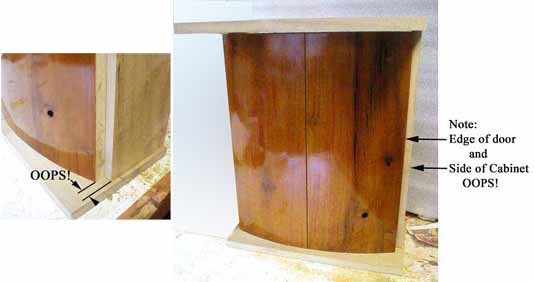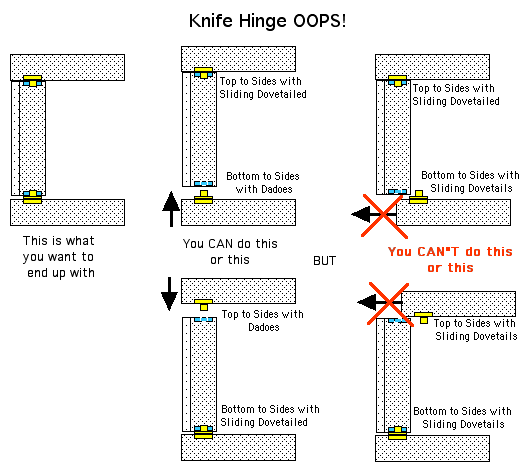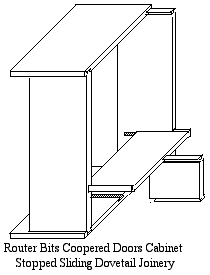Having used the MDF prototype of the cabinet to develop and make the two coopered doors, it was time to build the real cabinet to fit the coopered doors. I personally like stopped sliding dovetails for several reasons:
1. They hold things together mechanically
2. They don't require any glue so there's no frantic race agains the clock before the glue sets
....( if you do them right )
3. They're reversible ( since there's no glue they're easy to take apart if need be )
Here's what I decided on
- sliding dovetail the "top and bottom to the sides" joints
- sliding dovetail the top of the two drawers area to the sides of the cabinet
- sliding dovetail the drawer separator to the top of the two drawers area and the bottom of the cabinet
- dadoes in the sides for the slide out router bit shelves (not shown)
So I made the cabinet carcass/carcase, routing the sliding dovetail joinery on the JoinTech Cabinet Maker System. (you can go back to the site index and, in the Right Shop area, find JoinTech to find out more about this system) Because the fence is micro-adjustable, it was easy to make the female part of the joint just a tad wider to make assembly and disassembly easier (it's going to be put together and taken apart several times when I get to the hinges) and leave some space for glue - IF I ever decide to finished this cabinet.
The fit of the sliding dovetail joints was snug but didn't require any "beat to fit" during assembly nor for disassembly. Hurray! Carcass goes together, comes apart - and is self squaring. Nice!
And then . . .
I put the doors in place.

OOPS. Routed the dovetail groove ON THE WRONG SIDE OF THE LAYOUT LINE!
Made anothor top and bottom and THIS TIME routed the female part of the sliding dovetails on the CORRECT side of the layout lines. Put the "revised" cabinet parts together and was pleased to find that the doors fit, both in height AND width.
It was at that point that the next OOPS became apparent. You see, I 'm going to use knife hinges. They require that either the top or bottom.....be put on LAST and pushed down or up to set the hinge in place
!#&@^:**#######!!!!!

The solution - modify the bottom male dovetails on the cabinet's sides to tenons and make yet another new cabinet bottom - this time with stopped dadoes instead of stopped sliding dovetails. Easy right?
WRONG! The stopped dovetails in the top where done on a router table. The center of the dadoes in the new cabinet bottom had to line up with the stopped dovetails in the top. To change from the dovetail bit to a straight bit for the stopped dadoes required losing a critcal fence set up.
Now to the knife hinge installation ------>
<--- to the previous page
<----- back to the coopered door cabinet index
<----- back to the main index
